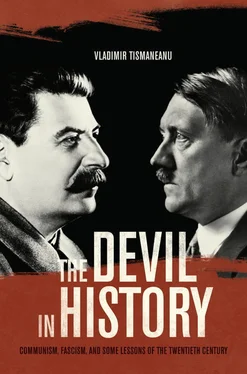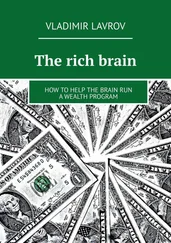The mind of the Stalinist elites in Eastern Europe was impressively revealed by the Polish journalist Teresa Toránska in a series of interviews conducted in the early 1980s with some former leaders of the Polish Communist Party. The most illuminating of these interviews is with the former Politburo member and Central Committee secretary Jakub Berman, who tried to defend the actions of his political generation. According to Berman, Polish Communists were right in championing Stalin’ policies in Poland because the Soviets guaranteed his country’s social and national liberation. The leaders of the Soviet-bloc Communist parties were convinced, like Lenin at the moment he founded the Bolshevik party, that the people needed an external force to enlighten them, that without such a vanguard party there was no hope of true emancipation. Berman was convinced that a day would come when mankind would do justice to this chiliastic dream of global revolution, and all the atrocities and crimes of Stalinism would be remembered only as passing incidents: “I am nonetheless convinced that the sum of our actions, skillfully and consistently carried out, will finally produce results and create a new Polish consciousness; because all the advantages flowing from our new path will be borne out, must be borne out, and… there will finally be a breakthrough in mentality which will give it an entirely new content and quality.” 94
In his absolute belief that history was on his and his comrades’ side, Berman was not alone. His was a mindset characteristic of the Communist elites in all Soviet satellite countries. Such (il)logic explains the frenzy of submission syndrome: the readiness to engage in any form of self-debasement and self-deprecation as long as such gestures were required by the party. The East European Communist leaders were seasoned militants for whom Stalin’s personality was an example of correct revolutionary conduct. They admired the Soviet leader’s intransigence and his uncompromising struggle against oppositional factions, and they shared his hostility to the West. They believed in the theory of permanent intensification of the class struggle and did their best to create a repressive system where critical tendencies could be immediately weeded out. Their minds were Manichean: Socialism was right, capitalism was wrong, and there was no middle road. During their Communist underground service, the Soviet-bloc Communists had learned to see Stalin’s catechistic formulations as the best formulations of their own thoughts and beliefs. They fully internalized a diabolical pedagogy based upon a belief in being ordained as both juror and executioner, for their legitimacy drew from a fanatical obedience to the vozhd. When Stalin died, his East European disciples were orphaned: more than their parties’ supporter, they lost their protector, the embodiment of their highest dreams, the hero they had come to revere, the symbol of their vigor, passion, and boundless enthusiasm.
The logic of Stalinism excluded vacillation and hesitation, numbed critical reasoning and intelligence, and instituted Soviet-style Marxism as a system of universal truth inimical to any form of doubt. The permanent purge, the basic technique of Stalinist demonology, was the modern equivalent of the medieval witch hunt. It was eagerly adopted by Stalin’s East European apprentices and adapted to their own purposes. Echoing Stalin’s fervid cult, East European leaders engineered similar campaigns of praise and idolatry in their own countries. The party was identified with the supreme leader, whose chief merit consisted in having correctly applied the Stalinist line. The solutions to all disturbing questions could be found in Stalin’s writings, and those who failed to discover the answers were branded “enemies of the people.” Members of the traditional political elites, members of the clergy, and representatives of the nationalist intelligentsia who had refused to collaborate with the new regimes were sentenced to long prison terms following dramatic show trials or cursory camera trials. That was the first stage of the purge in Eastern Europe. After 1949 the purges fed upon the Communist elites themselves, and through them many faithful Stalinists experienced firsthand the effects of the unstoppable terrorist machine they had helped set in motion.
Societies under Stalinism were restructured by a reimagining of class community, which in itself reflected these regimes’ visions of all-out conspiracies both internally and externally. As Sheila Fitzpatrick judiciously notes, it took only one step and “the imagined class basis of the conspiracy would fall away.” 95Class guilt frequently overlapped with national profiling during Stalin’s reign. Erik van Ree explains that for Stalin “national characters were shared by all members of the nation; they formed a ‘mentality [dukhovnyi oblik] of the people who come together in a nation.’ This ‘stable’ mentality was furthermore transmitted over time, as a ‘psychological makeup [psikhicheskii sklad] that was formed among them from generation to generation as a result of identical conditions of existence.’” 96Such an approach to the nationalities problem allowed Stalin to indulge in national stereotypes, which he superimposed upon Bolshevism’s ultrarationalistic vision of social engineering. In this worldview, Russians and other nationalities became the heroes storming any fortress, while those who were perceived as unwilling to dedicate themselves to Stalin’s “heroic modernity” were stigmatized as a decadent species spoiled by a profit-seeking mentality. This form of political romanticism played upon existing stereotypes in the population at large. No wonder that in the letters sent to Pravda in early 1953, most speakers agreed that “it was high time to purge Jews from the Party and from leading positions in state service and the professions.” The solution to the perceived treacherousness of the Jews was their “education through labor.” 97
Thus a central aspect of post-1945 purges both in the Soviet Union and Eastern Europe was Stalinist anti-Semitism. This phenomenon was rooted in Stalin’s own mentality, in the immediate aftermath of the war, and in the prejudices of majority populations in these countries. Even if some of its origins lay in the 1930s (after all, many of the Old Bolsheviks who were eliminated by Stalin were of Jewish origin), Stalinist anti-Semitism was a direct product of the Soviet leader’s post-1945 world-view. It may not have had the same murderous results as the Great Terror, but “it confused the European past”: “Stalinist anti-Semitism haunted Eastern Europe long after the death of Stalin. It was rarely a major tool of governance, but it was always available in moments of political stress. Anti-Semitism allowed leaders to revise the history of wartime suffering (recalled as the suffering only of Slavs) and also the history of Stalinism itself (which was portrayed as the deformed, Jewish form of communism).” 98Indeed, anti-Semitism resurfaced often during the existence of the Soviet bloc. In some cases, it was part and parcel of the building of socialist nations. As I discussed elsewhere, national Stalinism in Romania or in Poland or East Germany was characterized, among other things, by reaffirmation of the Jew among the archetypical Others of the dominant ethnic group. 99But the most destructive legacy of Stalinist anti-Semitism is its obfuscation of the Holocaust. Timothy Snyder excellently formulates this paradox: “So long as communists governed most of Europe, the Holocaust could never be seen for what it was.” 100In other words, Stalin’s mystification of the mass murder of the Jews set up the competitive regimes of memory in post-1989 East and Central Europe. On the one hand, for decades the Holocaust had not been remembered and the truth about the genocide of the Jews had remained hidden. On the other hand, the dimensions of the crimes of Stalinism and of the various Communist regimes were only surfacing to their true extent. Taking Snyder’s point a bit further, the silence about both the gulag and the Holocaust in Eastern Europe ensured that these radically traumatic historical experiences are yet to fully be a part of the common history of Europe. 101
Читать дальше












